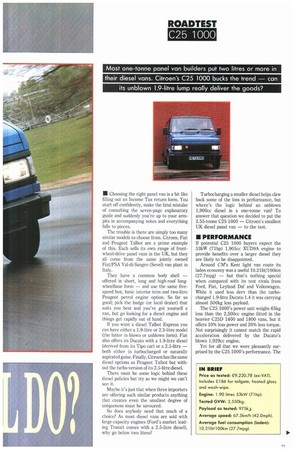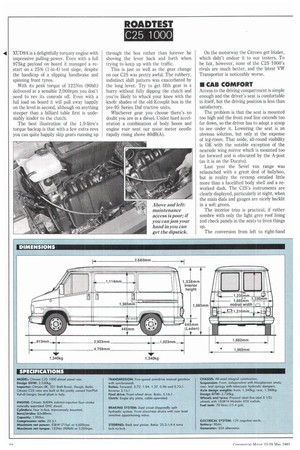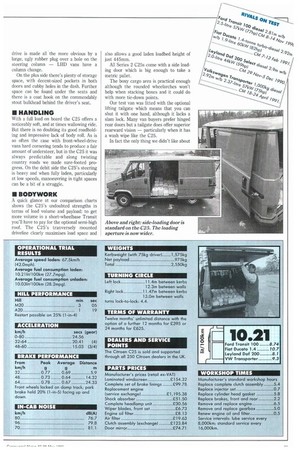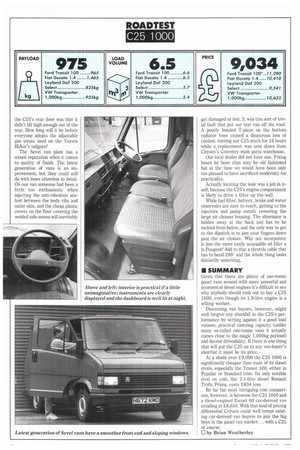• Choosing the right panel van is a bit like
Page 23

Page 24

Page 25

Page 26

If you've noticed an error in this article please click here to report it so we can fix it.
filling out an Income Tax return form. You start off confidently, make the fatal mistake of consulting the seven-page explanatory guide and suddenly you're up to your armpits in accompanying notes and everything falls to pieces.
The trouble is there are simply too many similar models to choose from. Citroen, Fiat and Peugeot Talbot are a prime example of this. Each sells its own range of frontwheel-drive panel vans in the UK, but they all come from the same jointly owned Fiat/PSA Val-di-Sangro (Sevel) van plant in Italy.
They have a common body shell — offered in short, long and high-roof longwheelbase form — and use the same fivespeed box, basic interior trim and two-litre Peugeot petrol engine option. So far so good; pick the badge (or local dealer) that suits you best and you've got yourself a van, but go looking for a diesel engine and things get rapidly out of hand.
If you want a diesel Talbot Express you can have either a 1.9-litre or 2.5-litre model (the latter in blown or unblown form). Fiat also offers its Ducato with a 1.9-litre diesel (derived from its Tipo car) or a 2.5-litre — both either in turbocharged or naturally aspirated guise. Finally, Citroen has the same diesel options as Peugeot Talbot but without the turbo version of its 2.5-litre diesel.
There must be some logic behind these diesel policies but try as we might we can't see it.
Maybe it's just that when three importers are offering such similar products anything that creates even the smallest degree of uniqueness roust be savoured.
So does anybody need that much of a choice? As most diesel vans are sold with large-capacity engines (Ford's market leading Transit comes with a 2.5-litre diesel), why go below two litres? Turbocharging a smaller diesel helps claw back some of the loss in performance, but where's the logic behind an unblown 1,900cc diesel in a one-tonne van? To answer that question we decided to put the 2.55-tonne C25 1000 — Citroen's smallest UK diesel panel van — to the test.
• PERFORMANCE
If potential C25 1000 buyers expect the 53kW (71hp) 1,905cc XUD9A engine to provide benefits over a larger diesel they are likely to be disappointed.
Around CM's Kent light van route its laden economy was a useful 10.21kt/100km (27.7mpg) — but that's nothing special when compared with its test rivals from Ford, Fiat, Leyland Daf and Volkswagen. While it used less dery than the turbocharged 1.9-litre Ducato 1.4 it was carrying almost 500kg less payload.
The C25 1000's power unit weighs 65kg less than the 2,500cc engine fitted in the heavier C25D 1400 and 1800 vans, but it offers 10% less power and 20% less torque. Not surprisingly it cannot match the rapid acceleration delivered by the Ducato's blown 1,929cc engine.
Yet for all that we were pleasantly surprised by the C25 1000's performance. The XUD9A is a delightfully torquey engine with impressive pulling power. Even with a full 975kg payload on board it managed a restart on a 25% (1-in-4) test slope, despite the handicap of a slipping handbrake and spinning front tyres.
With its peak torque of 122Nm (90bft) delivered at a sensible 2,000rpm you don't need to rev its conrods off. Even with a full load on board it will pull away happily on the level in second, although on anything steeper than a billiard table first is undeniably kinder to the clutch.
The best illustration of the 1.9-litre's torque backup is that with a few extra revs you can quite happily skip gears running up through the box rather than forever be shoving the lever back and forth when trying to keep up with the traffic.
This is just as well as the gear change on our C25 was pretty awful. The rubbery, indistinct shift pattern was exacerbated by the long lever. Try to get fifth gear in a hurry without fully dipping the clutch and you're likely to whack your knee with the knob: shades of the old Ecosplit box in the pre-95 Series Daf tractive units.
Whichever gear you choose there's no doubt you are in a diesel. Under hard acceleration a combination of body boom and engine roar sent our noise meter needle rapidly rising above 80dB(A). On the motorway the Citroen got louder, which didn't endear it to our testers. To be fair, however, none of the C25 1000's rivals are much better, and the latest VW Transporter is noticeably worse.
• CAB COMFORT
Access to the driving compartment is simple enough and the driver's seat is comfortable in itself, but the driving position is less than satisfactory.
The problem is that the seat is mounted too high and the front roof line extends too far down, so the driver has to adopt a stoop to see under it. Lowering the seat is an obvious solution, but only at the expense of leg-room. That aside, all-round visibility is OK with the notable exception of the nearside wing mirror which is mounted too far forward and is obscured by the A-post (as it is on the Ducato).
Last year the Sevel van range was relaunched with a great deal of ballyhoo, but in reality the revamp entailed little more than a facelifted body shell and a reworked dash. The C25's instruments are clearly displayed, particularly at night, when the main dials and gauges are nicely backlit in a soft green.
The interior trim is practical, if rather sombre with only the light grey roof lining and check panels in the seats to liven things up.
The conversion from left to right-hand drive is made all the more obvious by a large, ugly rubber plug over a hole on the steering column LHD vans have a column change.
On the plus side there's plenty of storage space, with decent-sized pockets in both doors and cubby holes in the dash. Further space can be found under the seats and there is a coat hook on the commendably stout bulkhead behind the driver's seat.
• HANDLING
With a full load on board the C25 offers a noticeably soft, and at times wallowing ride. But there is no doubting its good roadholding and impressive lack of body roll. As is so often the case with front-wheel-drive vans hard cornering tends to produce a fair amount of understeer, but in the C25 it was always predictable and along twisting country roads we made sure-footed progress. On the debit side the C25's steering is heavy and when fully laden, particularly at low speeds, manoeuvring in tight spaces can be a bit of a struggle.
• BODYWORK
A quick glance at our comparison charts shows the C25's undoubted strengths in terms of load volume and payload: to get more volume in a short-wheelbase Transit you'll have to pay for the optional semi-high roof. The C25's tranversely mounted driveline clearly maximises load space and also allows a good laden loadbed height of just 445mm.
All Series 2 C25s come with a side loading door which is big enough to take a metric pallet.
The boxy cargo area is practical enough although the rounded wheelarches won't help when stacking boxes and it could do with more tie-down points.
Our test van was fitted with the optional lifting tailgate which means that you can shut it with one hand, although it lacks a slam lock. Many van buyers prefer hinged rear doors but a tailgate does offer superior rearward vision particularly when it has a wash wipe like the C25.
In fact the only thing we didn't like about the C25's rear door was that it didn't lift high enough out of the way. How long will it be before everyone adopts the adjustable gas struts used on the Toyota HiAce's tailgate?
The Sevel van plant has a mixed reputation when it comes to quality of finish. The latest generation of vans is an improvement, but they could still do with more attention to detail. On our van someone had been a little too enthusiastic when injecting the anti-vibration sealant between the body ribs and outer skin, and the cheap plastic covers on the floor covering the welded side seams will inevitably -get damaged or lost. It was this sort of trivial fault that put our test van off the road. A poorly bonded 1-piece on the bottom radiator hose caused a disastrous loss of coolant, leaving our C25 stuck for 24 hours while a replacement was sent down from Citroen's Coventry main parts warehouse.
Our local dealer did not have one. Fixing hoses by hose clips may be old fashioned but at the time we would have been only too pleased to have sacrificed modernity for practicality, Actually locating the leak was a job in itself, because the C25's engine compartment is likely to drive a fitter up the wall.
While fuel filter, battery, brake and water reservoirs are easy to reach, getting to the injectors and pump entails removing the large air cleaner housing. The alternator is hidden away at the back and has to be tackled from below, and the only way to get to the dipstick is to jam your fingers down past the air cleaner. Why not incorporate it into the more easily accessible oil filler a la Peugeot? Add to that a throttle cable that has to bend 280° and the whole thing looks distinctly uninviting.
• SUMMARY
Given that there are plenty of one-tonne panel vans around with more powerful and economical diesel engines it's difficult to see why anybody should rush out to buy a C25 1000, even though its 1.9-litre engine is a willing worker.
Discerning van buyers, however, might well forgive any shortfall in the C25's performance by setting against it a good load volume, practical carrying capacity (unlike many so-called one-tonne vans it actually comes close to the magic 1,000kg payload) and decent driveability. If there is one thing that will put the C25 on to any van-buyer's shortlist it must be its price.
At a shade over £9,000 the C25 1000 is significantly cheaper than most of its diesel rivals, especially the Transit 100, either in Popular or Standard trim. Its only notable rival on cost, the 2.1-litre diesel Renault Trafic Prima, costs £634 less.
By far the most intriguing cost comparison, however, is between the C25 1000 and a diesel-engined Escort 60 car-derived van retailing at £8,650. With that kind of pricing differential Citroen could well tempt existing car-derived van buyers to join the big boys in the panel van market.., with a C25 of course.
LI by Brian Weatherley








































































































